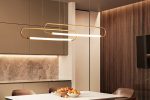The Danish Lamp, or Dansk Lampa as it is called in its home country, is a highly sought-after lighting fixture that has gained popularity all over the world since its introduction in the mid-20th century. This lamp, famous for its simple yet elegant design, reflects the Danish tradition of functionalism and craftsmanship that has become synonymous with Danish design.
Origins of the Danish Lamp
The Danish Lamp was first introduced in the 1940s by Le Klint, a Danish lighting company that was founded in 1943 by P.V. Jensen-Klint. The company was initially known for its hand-folded lampshades, which were made using traditional techniques that had been passed down from generation to generation. However, in the 1940s, the company realized the potential of modernist design and started experimenting with new materials and production techniques.
The Danish Lamp was one of the first products to come out of this new direction, and it was an instant hit. Designed by Esben Klint, the son of the founder, the lamp was a departure from the frilly, ornate lamps of the time. It featured a sleek, cylindrical shape made from high-quality materials, such as brass and glass.
The Design Philosophy behind the Danish Lamp
The Danish Lamp was not just a departure from traditional lamp design – it also represented a new way of thinking about industrial design. At the heart of this philosophy was the idea of functionalism, which emphasized the importance of form following function. In other words, a product should be designed to serve a specific purpose, and its aesthetics should be secondary to its utility.
The Danish Lamp embodies this philosophy by being both beautiful and functional. It has a simple, unadorned design that serves the practical purpose of providing light, while also being visually pleasing. The lamp’s construction is also a reflection of its design philosophy. It is made from high-quality materials that are both durable and aesthetically pleasing, such as brass, glass, and wood.
Design Features of the Danish Lamp
The Danish Lamp is characterized by several key design features, including:
- A cylindrical shape that tapers at the top
- A brass base and stem
- A glass shade that sits atop the base
- An adjustable shade that can be tilted to direct light where it is needed
These design features make the Danish Lamp both visually interesting and functional. The cylindrical shape gives it a sleek, modern look, while the brass and glass materials give it a sense of quality and durability. The adjustable shade allows users to direct light where it is needed, which makes it a practical addition to any room.
Impact of the Danish Lamp on Modern Design
The Danish Lamp has had a significant impact on modern design, both in Denmark and around the world. Its simple, functional design has become a hallmark of Danish design, and it has influenced countless other products, from furniture to architecture.
One of the most significant impacts of the Danish Lamp has been on the modern lighting industry. The lamp’s simple, elegant design has inspired countless other lighting fixtures, and its emphasis on function over form has helped to redefine what consumers expect from lighting products.
Another impact of the Danish Lamp has been on the broader field of industrial design. The lamp’s emphasis on craftsmanship and quality materials has helped to raise the bar for product design, and has led to a renewed focus on the value of traditional production techniques.
The Danish Lamp is a modern classic that has earned its place in the pantheon of design icons. Its simple, elegant design reflects the Danish philosophy of functionalism and craftsmanship, and it has had a significant impact on modern design, particularly in the lighting industry. Whether you’re a fan of modern design or simply appreciate quality craftsmanship, the Danish Lamp is a fixture that is worth adding to your collection.




